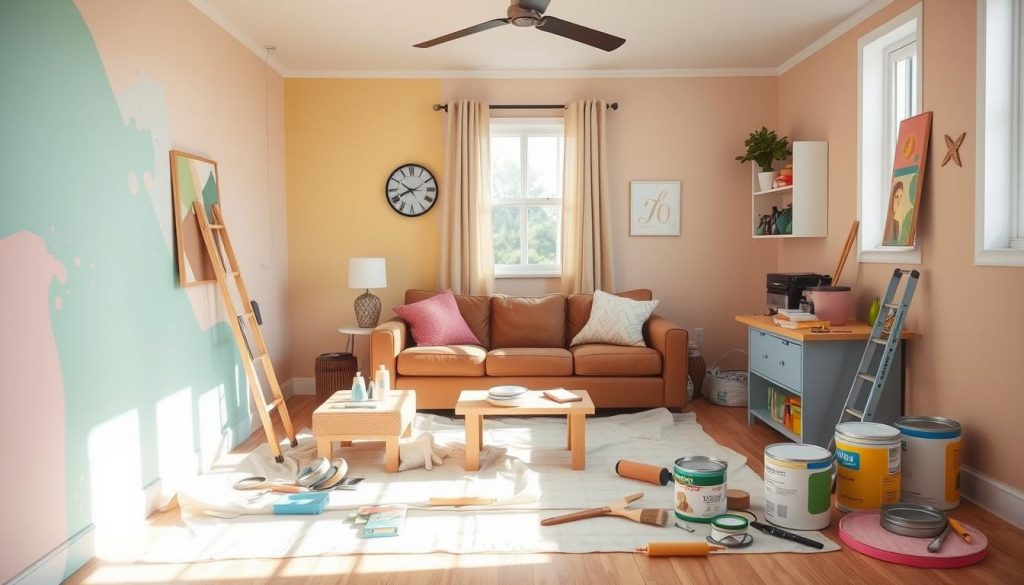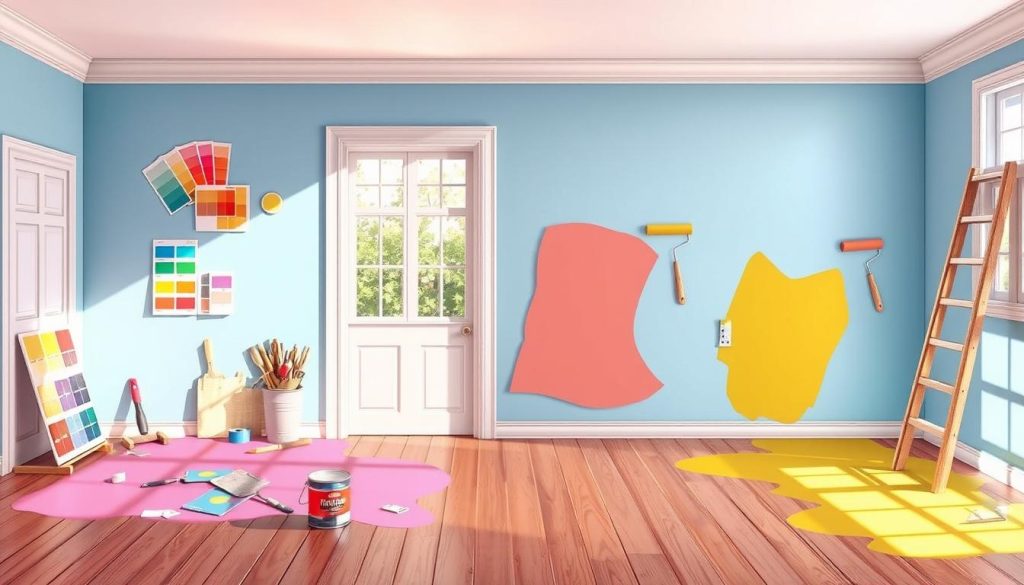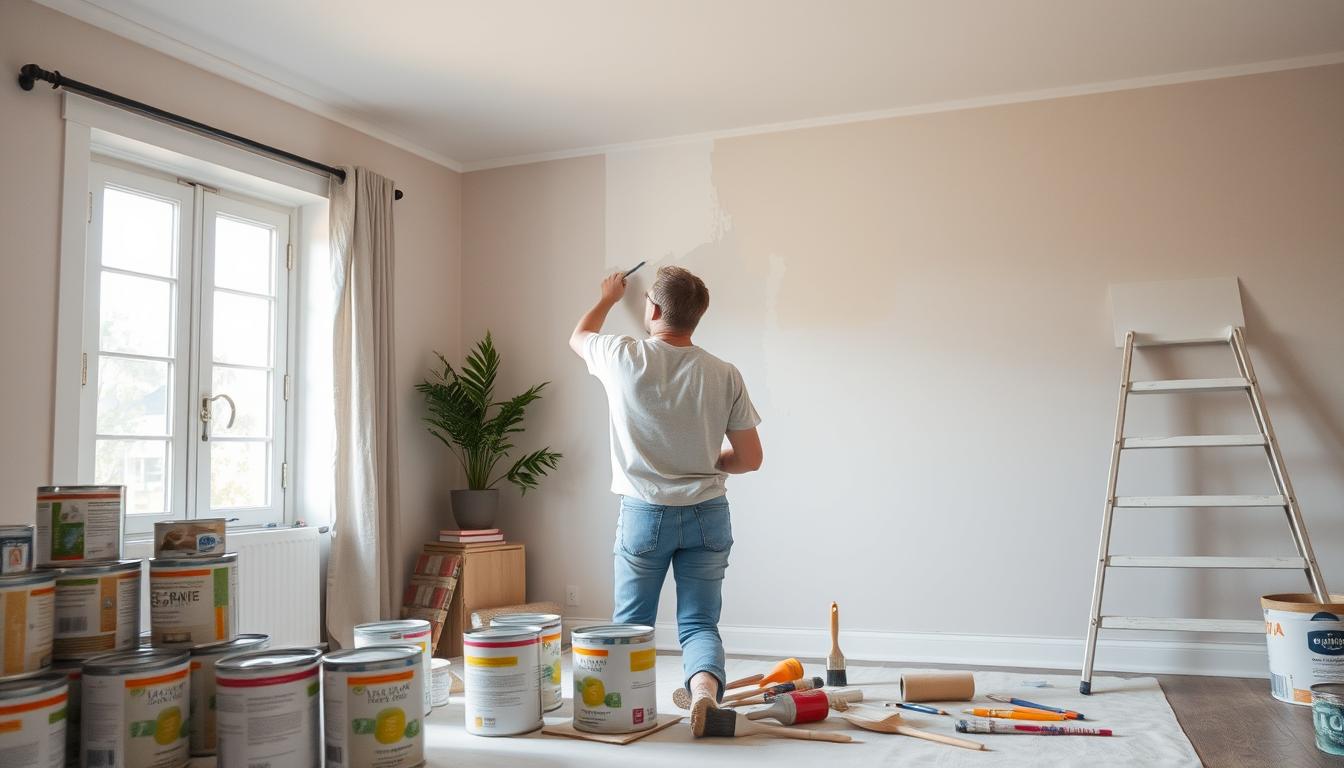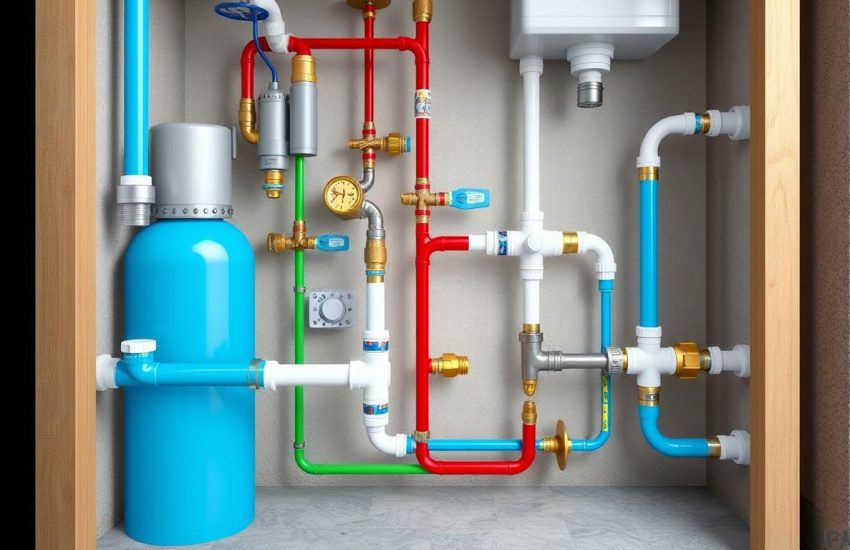Painting Tips: A Complete Guide for Homeowners
Did you know painting is not just popular but also saves money? Making your home look better by painting is simple and affordable. But what makes a paint job great?
Experts like Mauro Henrique say that 85% of a good paint job is preparation. It’s more than just painting walls. It involves careful planning, picking the best materials, and using the right techniques. Whether you’re painting yourself or hiring someone, understanding these secrets is key to improving your home.
Every step is important, from removing hardware to using painter’s tape correctly. Choosing quality brushes and the right roller covers is critical for a smooth finish. These steps not only make your home look better but also protect it. Let’s explore how paint can change your home with just a brush.
Key Takeaways
- The judicious application of paint can add significant value and aesthetic appeal to your home.
- Proper surface preparation is crucial for a long-lasting, high-quality paint job.
- Expert recommended paint brands, such as Sherwin Williams, Benjamin Moore, and Behr, offer varying levels of quality and finishes for different areas of the home.
- DIY painting provides an affordable alternative to professional services, with extensive preparation and correct techniques ensuring optimal results.
- Prioritizing the right paint finish can enhance the function and feel of any room, from high-gloss in high-traffic areas to flat finishes for a subtle elegance.
- Utilizing the right tools like synthetic bristle brushes for latex paints and microfiber rollers can significantly impact the paint application quality.
- A top-down, methodical approach to painting ensures both time efficiency and the protection of freshly-painted areas from splatters.
Why Focus on Painting Tips?
Home improvement gets a big boost from interior painting. It makes your space look and feel better. Brands like Sherwin Williams, Benjamin Moore, and Behr have many options. They meet homeowners’ diverse needs to enhance any room.
Interior painting is more than just making a room pretty. It protects inside and outside surfaces too. The right colors can change a room’s mood. They make it both prettier and easier to use.
Here are some key reasons why focusing on painting tips is important:
- Financial Prudence: Learning how to save money on painting tips cuts costs. It lets you update your home without spending too much.
- Aesthetic Enhancement: Good painting tips can make rooms look amazing. They enhance any room beyond your hopes.
- Protective Barrier: A new coat of paint keeps surfaces safe. It makes your home last longer.
A seasonal check of your home is also a smart move. For tips on keeping your home great all year, check out this detailed guide.
Smart painting tips make the job smoother and more fun. Choosing the best color and learning the best ways to paint are key. So, quality painting tips matter not just now. They keep your home looking great for a long time.
DIY vs Professional Help
Starting a painting project leaves homeowners wondering whether to use DIY tips or hire pros. Each choice has its pros and cons that affect the final look and happiness with the project.
DIY painting saves money because you don’t pay for labor. It does take a lot of time and effort. People who paint themselves can work whenever they want. They also learn new skills. Yet, getting the right tools and paint might be hard.
Hiring pros means getting top-notch results, even for tough jobs. Pros know the latest styles and how to make the paint last. They prepare the area and clean up after. This makes things easier for the homeowner.
| Aspect | DIY Painting | Professional Painting |
|---|---|---|
| Cost | More affordable, no labor costs | Higher cost, includes labor and expertise |
| Time & Flexibility | Work at own pace, requires more time | Efficient, set timeline |
| Quality & Finish | Depends on individual’s skill | Consistently high-quality, professional finish |
| Tools & Materials | Limited access to professional-grade tools | Access to best tools and high-quality paints |
| Preparation & Cleanup | Handled by individual | Fully managed by professionals |
Rick Watson from Sherwin-Williams says choosing DIY or pro painters depends on a few things. Think about your painting skills, the project’s difficulty, and the wall condition. Look at costs, time, and what quality you want for your project.
In the end, whether you choose affordable painting tips for DIY or professional help, both can change your space. Planning well and preparing carefully will make your painting project a success.
How to Save Money
Starting a home improvement project can be cheap. By following some affordable painting tips, you can lower your costs. Let’s look at ways to save money on painting tips but still keep quality.

Plan your painting projects when paint stores have big sales, like early spring. This takes advantage of seasonal deals. It helps cut down on how much you spend on paint.
Experts suggest using top-notch paints from Sherwin Williams, Benjamin Moore, and Behr. They last longer and don’t need many coats. To know how much paint to buy, use Benjamin Moore’s paint calculator. Check out this guide for tips.
- Stay updated with your favorite paint brands on social media for special deals.
- Trying out generic paints might work well. They can be as good as big brands but cheaper.
- Talking to experts can help you make smart choices. This way, you won’t waste money on errors.
Save more by using the same paint color in different rooms. Buying in bulk usually means discounts. You can also borrow tools or buy a complete painting kit. This reduces the need to buy new tools.
Work out the exact amount of paint you need to avoid extra buying. Choosing self-priming paints eliminates the need for a separate primer. This saves money on extra products.
Getting help from companies like Painter Bros can lead to better, cost-effective advice. Painting your home shouldn’t break the bank. With careful planning, your painting job can be both affordable and astonishing.
Step-by-Step Upgrades
Starting your interior painting project means planning well. This guide and DIY tips can help you make your space better.
First, get the room ready. Move furniture or cover it up. Check the walls for any cracks or holes. Fix them with spackle. Once it’s dry, sand it down. Make sure you work where air can flow, to stay safe from old paint dangers.

Paint from the top, beginning with the ceiling. This stops drips on walls you’ve already done. Use painter’s tape for sharp edges by doors and windows. High-quality brushes and rollers give you a neat finish.
For a great DIY painting job, you’ll need good primer, paint, rollers, brushes, painter’s tape, and drop cloths. Learning about colors and design can also help a lot.
- Pick the right paint (acrylic or oil-based) for your wall and the look you want.
- Use a primer first for better paint stick, fewer blisters, and longer-lasting color.
- Then put on at least two paint coats, letting each one dry well.
- Clean up well afterwards, keeping your tools for next time and avoiding messes.
Following these step-by-step painting steps will make your space better. Plus, you’ll feel proud of your home improvement work. Taking your time and paying attention to each step will make your design last longer and look great.
Final Tips for Success
As we finish our guide, remember that success in painting projects goes beyond paint. A smart DIY painter treasures a great 2 and 1/2-inch angled brush. They also know why blue painters’ tape is the best for neat edges. Learning how to be efficient and precise takes practice and patience, whether you’re improving your home or just making a room look better.
Using paint extenders is key to avoiding unwanted marks and getting a professional look. The right tools and how you apply paint matter a lot. Also, keeping painter’s tape on for a while helps make cleaner lines. Just be careful not to harm your surfaces.
Experts, like those from Sepi Painting and Waterproofing, Inc., bring valued knowledge. They started in October 1994 and offer more than just painting advice. They cover waterproofing, electrostatic painting, and chemical coatings too. After your hard work, cleaning and storing your brushes right is important. Think about how design and color mix together in every great piece. Each painting tip is part of the bigger picture of home improvement. Together, they make up the beauty of a finished painting project.



